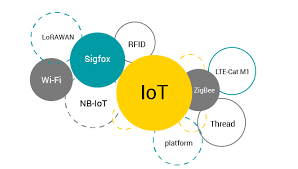In the ever-evolving landscape of technology, few advancements hold as much promise and potential for transformation as the Internet of Things (IoT). This groundbreaking paradigm shift in connectivity is revolutionizing the way we interact with the world around us, seamlessly integrating devices, sensors, and data to create smarter, more efficient systems. From smart homes and cities to industrial automation and healthcare, IoT technologies are reshaping industries, enhancing productivity, and improving quality of life. In this expansive exploration, we delve into the intricacies of IoT technologies, uncovering their impact, applications, and future possibilities.
1. Defining the Internet of Things:
At its core, the Internet of Things refers to the network of interconnected devices and objects that communicate and exchange data over the internet. These devices, equipped with sensors, actuators, and connectivity modules, collect and transmit data to enable real-time monitoring, analysis, and control of physical processes and environments.
2. Key Components of IoT:
- Sensors and Actuators: Sensors gather data from the physical world, such as temperature, humidity, motion, and light, while actuators enable devices to perform actions based on that data, such as adjusting thermostat settings or turning on lights.
- Connectivity: IoT devices rely on various connectivity technologies, including Wi-Fi, Bluetooth, Zigbee, and cellular networks, to transmit data to centralized servers or other devices for processing and analysis.
- Data Processing and Analytics: The vast amounts of data generated by IoT devices are processed and analyzed using advanced algorithms and machine learning techniques to derive actionable insights and optimize performance.
- Cloud Computing: Cloud computing platforms provide the infrastructure and resources needed to store, process, and analyze IoT data at scale, enabling real-time decision-making and predictive analytics.
3. Applications of IoT Technologies:
- Smart Homes: IoT-enabled smart home devices, such as thermostats, lighting systems, security cameras, and appliances, allow homeowners to control and automate various aspects of their homes remotely.
- Smart Cities: IoT technologies are transforming urban environments into smart cities by optimizing infrastructure, improving public services, and enhancing quality of life through applications such as smart transportation, waste management, energy distribution, and environmental monitoring.
- Industrial IoT (IIoT): In the industrial sector, IoT technologies are driving the Fourth Industrial Revolution, also known as Industry 4.0, by enabling connected factories, predictive maintenance, supply chain optimization, and remote monitoring of equipment and processes.
- Healthcare: IoT devices and wearables are revolutionizing healthcare by enabling remote patient monitoring, personalized medicine, telemedicine, and smart medical devices that improve patient outcomes and reduce healthcare costs.
- Agriculture: IoT technologies are enhancing agricultural productivity and sustainability through applications such as precision agriculture, smart irrigation systems, crop monitoring, and livestock tracking.
4. Challenges and Considerations:
- Security and Privacy: As IoT ecosystems become more interconnected and pervasive, concerns about cybersecurity, data privacy, and potential vulnerabilities become increasingly critical. Addressing these challenges requires robust security measures, encryption protocols, and regulatory frameworks to protect sensitive data and prevent unauthorized access.
- Interoperability: Ensuring interoperability and compatibility between different IoT devices and platforms is essential to enable seamless communication and integration across diverse ecosystems. Standardization efforts and open protocols play a crucial role in facilitating interoperability and fostering innovation.
- Scalability and Reliability: As the number of connected devices continues to grow exponentially, scalability and reliability become paramount considerations. Building resilient IoT architectures that can handle massive volumes of data, support real-time processing, and adapt to changing demands is essential for ensuring the long-term success of IoT deployments.
5. Future Trends and Possibilities:
- Edge Computing: Edge computing, which involves processing data closer to the source or edge of the network, is emerging as a critical enabler of IoT applications by reducing latency, conserving bandwidth, and enabling real-time analytics at the edge.
- 5G Connectivity: The rollout of 5G networks promises to unlock new opportunities for IoT by delivering ultra-fast, low-latency connectivity that enables high-bandwidth applications and supports a massive number of connected devices simultaneously.
- Artificial Intelligence and Machine Learning: AI and machine learning technologies are increasingly being integrated into IoT systems to enhance automation, enable predictive analytics, and derive actionable insights from IoT data in real time.
6. Conclusion:
In conclusion, the Internet of Things represents a monumental shift in the way we interact with technology and the world around us. By connecting devices, sensors, and data in a vast network of interconnected systems, IoT technologies are reshaping industries, transforming cities, and revolutionizing the way we live, work, and play. As the IoT ecosystem continues to evolve and mature, addressing challenges related to security, interoperability, and scalability will be crucial for unlocking its full potential and realizing the promise of a connected future. With ongoing innovation, collaboration, and investment, the Internet of Things has the power to drive unprecedented levels of efficiency, sustainability, and prosperity for generations to come.
